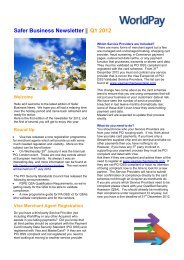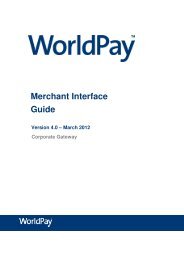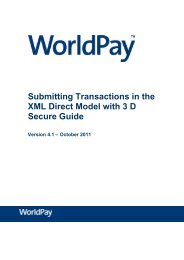- Page 1 and 2:
Connecting to PaymentTrust’s Secu
- Page 3 and 4:
3 STLink will return the following
- Page 5 and 6:
5 PaymentTrust Simultaneous Forced
- Page 7 and 8:
© 2000-2006 PaymentTrust Ltd. All
- Page 9 and 10:
3 Introduction The Secure Transacti
- Page 11 and 12:
11 Authentication Communication STl
- Page 13 and 14:
6 Transaction Specifications 6.1 Tr
- Page 15 and 16:
15 Supplementary (Q) Request: Payme
- Page 17 and 18:
Field Name Data Type Data Size Desc
- Page 19 and 20:
Field Name Data Type Data Size Desc
- Page 21 and 22:
Field Name Data Type Data Size Desc
- Page 23 and 24:
RiskGuardian Request (RG) with Requ
- Page 25 and 26:
Field Name Data Type Data Size Desc
- Page 27 and 28:
Field Name Data Type Data Size Desc
- Page 29 and 30:
Field Name Data Type Data Size Desc
- Page 31 and 32:
Field Name Data Type Data Size Desc
- Page 33 and 34:
Field Name Data Type Data Size Desc
- Page 35 and 36:
Field Name Data Type Data Size Desc
- Page 37 and 38:
STLink will return the following Re
- Page 39 and 40:
Field Name Data Type Data Size Desc
- Page 41 and 42:
Field Name Data Type Data Size Desc
- Page 43 and 44:
Field Name Data Type Data Size Desc
- Page 45 and 46:
Field Name Data Type Data Size Desc
- Page 47 and 48:
STLink will return the following it
- Page 49 and 50:
Field Name Data Type Data Size Desc
- Page 51 and 52:
Field Name Data Type Data Size Desc
- Page 53 and 54:
Field Name Data Type Data Size Desc
- Page 55 and 56:
Field Name Data Type Data Size Desc
- Page 57 and 58:
Field Name Data Type Data Size Desc
- Page 59 and 60:
Field Name Data Type Data Size Desc
- Page 61 and 62:
Field Name Data Type Data Size Desc
- Page 63 and 64:
Field Name Data Type Data Size Desc
- Page 65 and 66:
Field Name Data Type Data Size Desc
- Page 67 and 68:
Sample Response: MerchantId^100000~
- Page 69 and 70:
STLink will return the following it
- Page 71 and 72:
Field Name Data Type Data Size Desc
- Page 73 and 74:
PaymentTrust Forced Refund Request
- Page 75 and 76:
Sample Input String: StringIn=Versi
- Page 77 and 78:
Field Name Data Type Data Size Desc
- Page 79 and 80:
Field Name Data Type Data Size Desc
- Page 81 and 82:
Field Name Data Type Data Size Desc
- Page 83 and 84:
Field Name Data Type Data Size Desc
- Page 85 and 86:
Field Name Data Type Data Size Desc
- Page 87 and 88:
Field Name Data Type Data Size Desc
- Page 89 and 90:
Field Name Data Type Data Size Desc
- Page 91 and 92:
Field Name Data Type Data Size Desc
- Page 93 and 94:
Sample Input String: StringIn=Versi
- Page 95 and 96:
Field Name Data Type Data Size Desc
- Page 97 and 98:
Field Name Data Type Data Size Desc
- Page 99 and 100:
Field Name Data Type Data Size Desc
- Page 101 and 102:
PaymentTrust PayBack with Cheque Re
- Page 103 and 104:
Sample Input String: StringIn=Versi
- Page 105 and 106:
Field Name Data Type Data Size Desc
- Page 107 and 108:
STLink will return the following it
- Page 109 and 110:
STLink will return the following it
- Page 111 and 112:
Field Name Data Type Data Size Desc
- Page 113 and 114:
Field Name Data Type Data Size Desc
- Page 115 and 116:
Field Name Data Type Data Size Desc
- Page 117 and 118:
PaymentTrust Simultaneous Authoriza
- Page 119 and 120:
Field Name Data Type Data Size Desc
- Page 121 and 122:
Field Name Data Type Data Size Desc
- Page 123 and 124:
Field Name Data Type Data Size Desc
- Page 125 and 126:
PaymentTrust Refund Request (PT)(R)
- Page 127 and 128:
Field Name Data Type Data Size Desc
- Page 129 and 130:
Field Name Data Type Data Size Desc
- Page 131 and 132:
Field Name Data Type Data Size Desc
- Page 133 and 134:
3D Secure Requests 3D Secure Verify
- Page 135 and 136:
Field Name Data Type Data Size Desc
- Page 137 and 138:
42prrAKtOVtKyyJuebEvR6MOzpDExnYxLLM
- Page 139 and 140:
Foreign Exchange Requests Foreign E
- Page 141 and 142:
STLink will return the following it
- Page 143 and 144:
STLink will return the following it
- Page 145 and 146:
STLink will return the following it
- Page 147 and 148:
STLink will return the following it
- Page 149 and 150:
STLink will return the following it
- Page 151 and 152:
Field Name Data Type Data Size Desc
- Page 153 and 154:
Field Name Data Type Data Size Desc
- Page 155 and 156:
Field Name Data Type Data Size Desc
- Page 157 and 158:
Field Name Data Type Data Size Desc
- Page 159 and 160:
Field Name Data Type Data Size Desc
- Page 161 and 162:
Field Name Data Type Data Size Desc
- Page 163 and 164:
Field Name Data Type Data Size Desc
- Page 165 and 166:
Field Name Data Type Data Size Desc
- Page 167 and 168:
Supplementary Requests Supplementar
- Page 169 and 170:
Sample Response: MerchantId^100000~
- Page 171 and 172:
STLink will return the following Re
- Page 173 and 174:
STLink will return the following it
- Page 175 and 176:
Supplementary (Q) Request for Batch
- Page 177 and 178:
Field Name Data Type Data Size Desc
- Page 179 and 180:
STLink will return the following it
- Page 181 and 182:
Field Name Data Type Data Size Desc
- Page 183 and 184:
Field Name Data Type Data Size Desc
- Page 185 and 186:
Field Name Data Type Data Size Desc
- Page 187 and 188:
Field Name Data Type Data Size Desc
- Page 189 and 190:
6.3 XML Definitions RiskGuardian Re
- Page 191 and 192:
RiskGuardian Request (RG) with Requ
- Page 193 and 194:
- Page 195 and 196:
Data Sharing PayBack with Electroni
- Page 197 and 198:
Request Response 197
- Page 199 and 200:
PaymentTrust
- Page 201 and 202:
PaymentTrust Deposit (Settlement) R
- Page 203 and 204:
PaymentTrust Simultaneous Authoriza
- Page 205 and 206:
Payment
- Page 207 and 208:
PaymentTrust PayBack with Cheque Re
- Page 209 and 210:
PaymentTrust Bank Transfer ID Reque
- Page 211 and 212: Request Response
- Page 213 and 214: Request Response
- Page 215 and 216: Request Response
- Page 217 and 218: Request Response
- Page 219 and 220: PaymentTrust Forced Authorization B
- Page 221 and 222: PaymentTrust Deposit (Settlement) B
- Page 223 and 224: PaymentTrust Forced Refund Batch Re
- Page 225 and 226: Request Response 225
- Page 227 and 228: Request Response
- Page 229 and 230: PaymentTrust PayBack with Credit Ca
- Page 231 and 232: PaymentTrust PayBack with Electroni
- Page 233 and 234: PaymentTrust Deposit (Settlement) B
- Page 235 and 236: PaymentTrust Simultaneous Authoriza
- Page 237 and 238: PaymentTrust Refund Batch Request (
- Page 239 and 240: 3D Secure Verify Enrollment Request
- Page 241 and 242: Foreign Exchange Refund Request (FX
- Page 243 and 244: Identify Me Request (IM) Request Re
- Page 245 and 246: RiskGuardian (RG) Supplementary (Q)
- Page 247 and 248: PaymentTrust (PT) Supplementary (Q)
- Page 249 and 250: Foreign Exchange Supplementary (Q)
- Page 251 and 252: DataShare: Historical Data Loading
- Page 253 and 254: Colum Data M=Mandatory Fields n Fie
- Page 255 and 256: Colum Data M=Mandatory Fields n Fie
- Page 257 and 258: Colum Data M=Mandatory Fields n Fie
- Page 259 and 260: Colum Data M=Mandatory Fields n Fie
- Page 261: Colum Data M=Mandatory Fields n Fie
- Page 265 and 266: C++ code sample Communication with
- Page 267 and 268: { // HTTPS pFile = pConnection->Ope
- Page 269 and 270: Whereas the OpenUrl method returns
- Page 271 and 272: ' Submit to the STLink and store th
- Page 273 and 274: Java sample code The following Java
- Page 275 and 276: 275 urlConnection = url.openConnect
- Page 277 and 278: 277 StringTokenizer st2 = new Strin
- Page 279 and 280: Currency IDs 279 Country Name Count
- Page 281 and 282: PaymentTrust Result Codes 281 Appen
- Page 283 and 284: Message Code Description Explanatio
- Page 285 and 286: Message Code Description Explanatio
- Page 287 and 288: Message Code Description Explanatio
- Page 289 and 290: Country Codes 289 Appendix E Countr
- Page 291 and 292: 291 Country Name ISO Country Code G
- Page 293 and 294: 293 Country Name ISO Country Code Q
- Page 295 and 296: State/Province/Region Codes 295 App
- Page 297 and 298: State/Region Code Country Australia
- Page 299 and 300: Commodity Code Description 9360 EMP
- Page 301 and 302: Commodity Code Description 6360 STO
- Page 303 and 304: Glossary of useful terms A ABA See
- Page 305 and 306: One one-hundredth of a percent. Dis
- Page 307 and 308: Conversion Rate The conversion rate
- Page 309 and 310: Fraudulent Transaction A transactio
- Page 311 and 312: MSP See Member Service Provider. N
- Page 313 and 314:
Qualification A level at which a tr
- Page 315 and 316:
Track 1 Bank discretionary data enc






